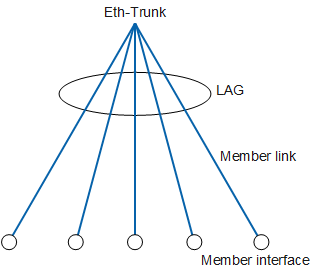Basic Concepts
LAG and LAG Interface
A link aggregation group (LAG) is a logical link composed of multiple Ethernet links.
Each LAG has one logical interface, known as a link aggregation interface or Eth-Trunk, which can be treated as a physical Ethernet interface. The only difference between the Eth-Trunk and physical Ethernet interface is that the Eth-Trunk needs to select one or more member interfaces to forward traffic.
Member Interface and Member Link

Active and Inactive Interfaces and Links
There are two types of interfaces in a LAG: active interfaces that forward data and inactive interfaces that do not forward data.
The link connected to an active interface is the active link, and the link connected to an inactive interface is the inactive link.
Upper Threshold for the Number of Active Interfaces
The upper threshold is used to improve network reliability with assured bandwidth. When the number of active interfaces reaches this threshold, you can add new member interfaces to the Eth-Trunk, but excess member interfaces only go Up to back up active interfaces that go Down.
For example, 8 fully-functioning member links bundle into an Eth-Trunk link, with each link providing a bandwidth of 1 Gbit/s. If the Eth-Trunk link only needs to provide a maximum bandwidth of 5 Gbit/s, you can set the maximum number of Up member links to 5 or larger. Then any unselected Up links automatically enter the backup state, improving reliability.

The upper threshold for the number of active interfaces is inapplicable to the manual load balancing mode.
Lower Threshold for the Number of Active Interfaces
When the number of active interfaces falls below the lower threshold, the Eth-Trunk goes Down. This ensures that an active Eth-Trunk has the minimum required bandwidth.
For example, if the Eth-Trunk is required to provide a minimum bandwidth of 2 Gbit/s and each member link's bandwidth is 1 Gbit/s, the minimum number of Up member links must be set to 2 or larger.
Link Aggregation Mode
Link aggregation can work in manual or Link Aggregation Control Protocol (LACP) mode. For details, see Link Aggregation in Manual Mode and Link Aggregation in LACP Mode.
Link Aggregation Methods
- Intra-device: Member interfaces of an Eth-Trunk are located on the same device.
- Inter-stack-device: Member interfaces of an Eth-Trunk are located on member devices of a stack. For details, see Link Aggregation in Stack Scenarios.
- Inter-device: The inter-device link aggregation refers to E-Trunk. E-Trunk allows links between multiple devices to be aggregated using LACP. For details, see E-Trunk.